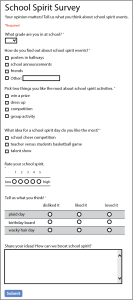Google Forms is a web-based app used to create forms for data collection purposes. Students and teachers can use Google Forms to make surveys, quizzes, or event registration sheets. The form is web-based and can be shared with respondents by sending a link, emailing a message, or embedding it into a web page or blog post. Data gathered using the form is typically stored in a spreadsheet. Although there are other online survey apps, Google Forms is an excellent free option.

Here are the top 5 reasons to use Google Forms:
1. Create Surveys to Meet Curriculum Objectives
It is likely that your students are required to make surveys. Take a look at your math curriculum. Learning objectives typically include research design, data collection, data analysis, and reporting outcomes (often these appear in the data management, statistic, and/or probability section). Now take a look at your science curriculum. Scientific inquiry should be listed as a learning objective, which includes asking questions, collecting data, organizing findings, analyzing and interpreting data, and communicating results.
The great news is that Google Forms can help your students meet curriculum requirements! Your students will be able to pose a meaningful research question, select a sample group from the population using an appropriate sampling technique, design a questionnaire without question bias, administer the survey, analyze the data using graphs, data tables, and pivot charts, and draw conclusions from the data. Google Forms is a useful tool for meeting objectives.
2. Ask Various Types of Questions
Google Forms allows you to ask both open-ended and closed-ended questions. You can use drop down menus, multiple choice, checklists, rating scales, and short answers text boxes to gather data. Below are the types of questions you can use in a Google Form:
- Text
- Paragraph Text
- Multiple Choice
- Checkboxes
- Choose from a list
- Scale
- Grid
- Date
- Time
3. Apply Validation Options to Control Data Entry
Data validation is a rule applied to data entry to make sure that the information is correct and/or useful. Google Forms offers many options for controlling answers provided by respondents. Questions can be set to required to prevent respondents from skipping a question. A number or text can be restricted to a specific entry, character count, or range. A checklist can have the number of options selected limited. As well, the order of choices for a question can be shuffled to avoid placement within a list influencing selection. Validation options provided by Google Forms help to improve the quality of the data recorded.
4. Create Professional Looking Forms using Themes
Google Forms helps you create a professional looking form. Themes are available allowing you and your students to select from over twenty pre-set designs. In addition, a custom option promotes creativity. The header, text, form background, and page background can all be customized. It is fun to explore the library of header images (some are animated!). One feature I like is the ability to set the page background. You can upload a picture, take a snapshot, or load an image from a URL or Google Drive to create a custom look. With so many web apps limiting the creative process, it is refreshing that form appearance is not restricted to only a few templates in Google Forms.
5. Multiple Ways to Administer Forms
Google Forms lets you and your students collect data using multiple methods. A form can be included in the body of an email allowing a respondent to submit their responses from their Inbox. A link can be generated allowing respondents to answer the questions using a web-based form. Code can be generated and then embedded into a blog or web page as another option for data collection. As well, if a paper/pencil method is preferred the form can be converted into a PDF file using Google Chrome.
There are so many more reasons to use Google Forms – these are just a few. Look for a future post with even MORE reasons you should use Google Forms.
